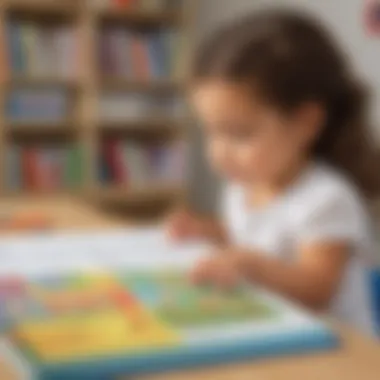Engaging Young Minds: Blended Sounds in Kindergarten


Intro
Blended sounds are essential elements in early literacy development for kindergarten-aged children. Understanding phonemic awareness and being able to blend sounds opens up pathways to reading and comprehension skills. In this article, we will methodically explore the concept of blended sounds, providing insights and practical methods to aid educators and parents. The significance of teaching blended sounds cannot be overstated, as they lay the foundation for a child's ability to decode words and improve their overall language skills.
Creative Activities
Engaging children in creative activities can facilitate the understanding of blended sounds greatly. This section will unveil various craft ideas centered on this theme.
Craft Ideas
- Sound Blending Posters: Children can create posters that visually represent different blended sounds. They can use drawings or images from magazines to illustrate words that include these sounds.
- Blended Sound Cards: Create index cards for each blended sound. For instance, a card with 'cl' can have images of a cloud and a clown. This can help children visualize and remember the sounds better.
Step-by-Step Guides
Creating Sound Blending Posters
- Gather materials such as poster boards, markers, scissors, and magazines.
- Choose a blended sound to focus on, like 'br'.
- Cut out pictures from magazines that represent the sound and glue them onto the poster.
- Write the blended sound and some example words at the bottom of the poster.
Making Blended Sound Cards
- Use index cards or cut pieces of cardboard into small rectangles.
- Write a blended sound on one side of the card.
- List words that include that sound with tiny images next to them.
- Allow kids to decorate the cards to make them visually appealing.
Educational Value
Participating in such activities not only makes learning engaging but also strengthens phonemic awareness. Children learn by doing, and these hands-on craft ideas reinforce their understanding of how sounds combine to form words. It aids in memory retention and can create a fun bonding experience for the child and the adult.
Fun Quizzes
Quizzes provide an interactive way to solidify what children have learned about blended sounds. Here are some aspects of how quizzes can enhance learning.
Quiz Topics
Common topics in quizzes available on ElemFun may include:
- Identifying blend sounds within words
- Matching pictures to words that contain blended sounds
- Categorizing words based on various blends
Question Types
Variety in question types keeps engagement high. Quizzes may include:
- Multiple-choice questions
- Fill-in-the-blank activities
- True or false statements
Knowledge Reinforcement
Quizzes facilitate knowledge reinforcement by allowing children to practice what they have learned. As they answer questions correctly, it builds confidence and helps retain information better.
Fact-Based Articles
Fact-based articles serve as an additional resource for both educators and parents. They can provide an enriched understanding of blended sounds and their importance in literacy development.
Topics
These articles cover a broad range of topics including:
- The science behind phonemic awareness
- Techniques for teaching blended sounds
- The impact of blended sounds on overall reading skills
Engaging Content
The content is presented in an accessible manner, ensuring that even complex ideas are easily digestible. This makes it suitable for both educators and parents who want to support children in their learning journey.
Intro to Blended Sounds
Blended sounds are a foundational concept in phonics and early literacy. Understanding these sounds helps children decode and construct words. This section will delve into what blended sounds are, and their significance in a child's literacy development.
Definition of Blended Sounds


Blended sounds refer to the combination of phonemes to produce distinct sounds that form the basis of spoken words. For example, in the word "blender," the 'bl' represents a blend of the sounds 'b' and 'l'. These combinations allow children to perceive and produce language more effectively.
Blending can involve initial consonant blends, like 'str' in "street," or final blends, like 'nd' in "fund." Teaching children to recognize and create these combinations equips them with the necessary groundwork for reading and writing.
Importance in Early Literacy
Blended sounds play a critical role in early literacy. Recognizing and using blended sounds helps young learners develop their phonemic awareness. This awareness is the ability to hear, identify, and manipulate phonemes in spoken language.
Understanding blended sounds encourages children to:
- Improve their decoding skills, which aids in reading comprehension.
- Build a larger vocabulary through exposure to various word structures.
- Enhance spelling skills by connecting sound with the written form.
"Blended sounds are a stepping stone to literacy, allowing children to form connections between sounds and letters."
Integrating blended sounds into the learning process supports not only reading skills but also fosters confidence in communication. Children who grasp these concepts early are positioned to be more successful as they progress through their education.
Phonemic Awareness
Phonemic awareness is a critical skill in early literacy development. It refers to the child's ability to hear, identify, and manipulate the individual sounds in spoken words, which are known as phonemes. This foundational skill is essential for mastering the processes of reading and writing. Without strong phonemic awareness, children often face challenges in decoding words and recognizing how sounds form the basis of language.
Understanding phonemes involves recognizing that even though letters represent sounds, spoken words are made of different segments. Children must grasp that words like "cat" consist of three distinct sounds: /k/, /æ/, and /t/. This auditory processing not only helps in developing reading skills but also bolsters spelling abilities, a key factor in literacy.
The benefits of phonemic awareness are numerous. For one, it enhances reading fluency; children who can easily blend sounds can read more smoothly. It also encourages vocabulary expansion, as children learn to break down and construct words. Moreover, phonemic awareness is linked to later academic success, making it a priority in kindergarten education.
Key considerations about phonemic awareness include:
- Age Appropriateness: Children's abilities vary widely at early ages. Activities should match their developmental stage.
- Continuous Practice: Regular engagement with phonemic activities can reinforce skills and promote retention.
- Assessment Forms: Tools like phonemic segmentation tasks or sound manipulation games can offer insights into children's level of understanding.
"Phonemic awareness is a building block that supports all future learning in reading and writing."
Understanding Phonemes
To delve deeper into phonemic awareness, we must unpack what phonemes truly are. Phonemes are the smallest units of sound that can change the meaning of a word. For example, changing the initial sound in the word "bat" to /k/ gives us a completely different word: "cat." Thus, phonemes play a pivotal role in language.
There are approximately 44 phonemes in English, and they can represent single letters or combinations of letters. Recognizing these sounds and their variations is crucial for children as they embark on the literacy journey. Parents can support this understanding by using everyday experiences, such as listening to sounds in their environment and discussing them.
Role of Phonemic Awareness in Blending
Phonemic awareness significantly impacts a child's ability to blend sounds. Blending is the process of combining individual sounds to pronounce a word. Without the ability to blend phonemes, children may find reading exercises to be perplexing. This skill helps young learners move from isolated sounds to whole words.
Engaging in blending exercises allows children to practice linking phonemes together. For instance, when they hear the sounds /d/, /o/, and /g/, they can blend these phonemes to form the word "dog." This exercise can be made interactive using various techniques like clapping out sounds or using visual aids.
Furthermore, phonemic awareness can elevate a child's confidence. As they become proficient in blending, their fear of failure diminishes. This is particularly crucial as literacy is foundational for their entire educational experience. When children master blending, they gain independence and motivation in their reading practices, positioning them for greater success.
Teaching Strategies for Blended Sounds
Teaching strategies for blended sounds are essential for effectively developing early literacy skills in kindergarten children. These strategies help children understand how sounds combine to create words, which is vital for reading success. By applying these methods, educators can engage children at various levels of learning. The key is to use a blend of direct instruction, multi-sensory approaches, and interactive activities. Each of these strategies caters to different learning styles, ensuring that all children have the opportunity to grasp the concept of blended sounds.
Direct Instruction
Direct instruction plays a significant role in teaching blended sounds. This approach involves clear, straightforward teaching methods that allow educators to model blending effectively. Utilizing systematic phonetic lessons, teachers demonstrate how individual phonemes combine to create whole words. For example, when teaching the word "cat," the instructor articulates the sounds /k/, /a/, and /t/ separately before blending them together.
To enhance effectiveness, educators can employ visual aids like flashcards displaying letters and corresponding images. Reinforcing these concepts through repetition helps solidify understanding. Direct instruction requires careful monitoring of student comprehension. Adjusting pace and frequency based on student responses can ensure that no child is left behind. This method fosters a structured learning environment and sets the groundwork for further literacy skills.
Multi-sensory Approaches
Multi-sensory approaches are invaluable in teaching blended sounds as they engage multiple senses, enhancing the learning experience. This technique incorporates visual, auditory, and kinesthetic elements, appealing to diverse learning styles.
Activities can range from using colored letters to represent sounds, allowing children to see and manipulate the letters as they work on blending. Incorporating tactile experiences, such as using playdough to form letters or sounds, gives children a physical aspect to connect with learning.
In this method, songs and rhymes are also beneficial. These auditory components help reinforce phonemic awareness through rhythm and melody. The integration of various sensory modalities not only makes learning enjoyable but also helps improve retention and recall of blended sounds. Thus, multi-sensory techniques, when thoughtfully applied, can significantly boost phonics learning in young children.
Games and Activities
Incorporating games and activities to teach blended sounds engages children actively and makes learning enjoyable. Playful interactions help reduce anxiety around learning while promoting social skills among peers.


Several effective options include:
- Sound matching games: Children match words with similar sounds or beginning letters, reinforcing phonemic recognition.
- Blending bingo: Create bingo cards with different word blends, allowing children to call out and match sounds to their corresponding letters.
- Interactive digital games: Many online resources offer phonics games tailored for young learners, providing immediate feedback and a fun learning experience.
These activities not only enhance understanding of blended sounds but also promote teamwork and communication skills. Involving parents and caregivers in these activities can further enhance the learning experience, allowing children to practice in a supportive environment.
Engaging, play-based learning strategies for blended sounds can lead to significant improvements in early literacy skills.
By blending various teaching strategies, educators can adapt lessons to meet the needs of every child in the classroom. Encouraging participation, curiosity, and exploration helps children develop a strong foundation in phonics. This comprehensive approach lays the groundwork for proficient reading skills and a lifelong love of learning.
Practical Resources for Educators
In the landscape of early childhood education, particularly within the realm of teaching blended sounds, practical resources play a pivotal role. These resources not only support educators in lesson planning but also enrich the learning experience for kindergarten children. In a world where literacy skills are paramount, effective tools can be the bridge to enhance understanding and engagement among young learners.
Interactive Phonics Worksheets
Interactive phonics worksheets serve as essential resources for educators aiming to teach blended sounds effectively. These worksheets engage students actively, allowing them to practice sound blending through various exercises. When children work with such materials, they can see the relationship between sounds and letters.
Benefits of using interactive worksheets include:
- Individualized Learning: Worksheets can cater to diverse learning paces.
- Focused Practice: They provide concentrated practice on specific sounds or blends, reinforcing skills.
- Visual Learning: Worksheets often include visual elements that support comprehension through imagery.
As educators select interactive worksheets, it is crucial to consider the variety of activities included. Worksheets should incorporate matching exercises, fill-in-the-blank sentences, and sound sorting to cover different aspects of blended sounds.
Online Phonics Games
The integration of online phonics games into teaching practices brings numerous advantages. These games can capture the attention of kindergarten students, making the process of learning blended sounds enjoyable. Children gravitate toward games due to their interactive nature and immediate feedback, which can further motivate them to practice.
A few key benefits of online phonics games are:
- Engagement: The game format encourages active participation, keeping students motivated.
- Immediate Feedback: Online platforms often provide instant feedback, helping learners understand their progress.
- Accessibility: Many games are easily accessible on various devices, allowing for learning beyond the classroom.
When introducing online phonics games, educators should aim for a balance between fun and educational value. Selecting games that focus specifically on blended sounds reinforces learning in a seamless manner.
Phonics Apps for Kindergarten
Phonics apps are becoming increasingly popular among educators and parents alike. These applications can offer a portable, convenient way to teach blended sounds. The best apps are designed specifically for kindergarten children and incorporate engaging visuals, sounds, and interactive tasks that foster learning.
Some noteworthy features of effective phonics apps include:
- Customizable Learning Paths: Many apps allow children to learn at their own pace, adapting to their individual needs.
- Progress Tracking: They often include progress tracking mechanisms, providing valuable insights for parents and teachers.
- Fun Elements: Gamification techniques such as rewards and levels keep children interested.
In selecting phonics apps, it is important for educators to review the content and interface. An app that is age-appropriate and user-friendly enhances the overall learning experience.
In summary, practical resources are essential for making blended sounds accessible and engaging for young learners. They foster a dynamic learning environment that cultivates phonemic awareness and literacy skills.
Assessment of Blended Sounds
Assessment of blended sounds is a critical aspect of literacy education for kindergarten students. Understanding how well children can identify and manipulate sounds sets the stage for their success in reading and writing. This type of assessment not only reflects a child's current abilities but also helps educators tailor their teaching strategies. Evaluating blended sounds allows educators to identify areas where a child may struggle, providing insights for targeted interventions.
There are several benefits to implementing effective assessment strategies for blended sounds:
- Individualized Learning: Assessments enable educators to personalize instruction to meet each child's needs. This ensures that all children progress at their own pace.
- Data-Driven Decisions: Using assessment results, educators can make informed decisions about curriculum adjustments or interventions needed for particular students.
- Monitoring Progress: Regular assessments help track a child's development over time. This can be encouraging for students and reassuring for parents.
- Identifying Trends: Teachers can spot classroom-wide trends in sound blending abilities. This could suggest a need to modify the overall approach to phonics instruction.
Overall, assessment is not just about testing students; it is about understanding and enhancing their learning experience.
Observational Assessments
Observational assessments involve watching and recording students as they engage in activities related to blended sounds. These assessments can provide rich qualitative data that standardized tests often miss.
By observing children in natural settings, teachers can gain insights into their thinking processes and understanding.
Key aspects of observational assessments include:
- Contextual Learning: Observations take place in real contexts, helping the teacher understand how children interact with sounds during normal activities.
- Flexibility: Teachers can assess children as they partake in games or group activities, allowing for a more relaxed atmosphere.
- Engagement Levels: Observations can also reflect students' levels of engagement with phonics concepts. Eager participation often correlates with a greater understanding of blended sounds.
Phonics Screening Tools


Phonics screening tools provide a systematic method to assess a child's ability to blend sounds. These tools often include a combination of oral assessments, written tasks, and specific phoneme manipulation exercises. They are designed to provide quick insights into a child's phonics knowledge and blending capability.
Some important features of phonics screening tools are:
- Standardized Measures: These tools often come with established benchmarks, making it easier for educators to understand where a child stands compared to peers.
- Structured Format: Screening tools guide the assessment process, ensuring that all necessary areas are covered during evaluation.
- Immediate Feedback: Results from phonics screening tools can be analyzed quickly, allowing for prompt instructional adjustments.
Using both observational assessments and phonics screening could provide a comprehensive understanding of a child’s mastery over blended sounds. Educators can combine qualitative insights with quantitative data to inform their teaching practices efficiently.
Challenges in Teaching Blended Sounds
Teaching blended sounds presents several challenges that educators must navigate to foster effective literacy skills among kindergarteners. Understanding these challenges is crucial. The precursors to reading involve complex cognitive processes. Young learners often face a mix of obstacles that may impede their ability to recognize and combine sounds smoothly.
Common Misconceptions
One of the central challenges relates to misconceptions about blended sounds themselves. Many people believe that mastering phonics happens naturally and does not require systematic instruction. However, this assumption can lead to frustration in both students and teachers.
For instance, some children may confuse blended sounds with similar sounding phonemes. They might hear the blended sounds incorrectly during phonics activities, leading to errors during reading. Teachers often deal with this by providing clear examples and frequent practice.
Additionally, there is a perception that blending phonemes is an easy task. In reality, it demands a combination of auditory discrimination and articulation skills. Young learners can struggle to hear, segment, or blend sounds correctly. This misunderstanding can undermine efforts to teach blended sounds effectively.
Addressing Diverse Learning Needs
Every child is unique, and this diversity extends to their learning styles and paces. A significant challenge is customizing instruction to meet these varied needs. Some children may excel with auditory instruction, while others may require visual supports to grasp blended sounds. Providing differentiated lessons becomes essential to accommodate these differences.
Setting up small groups based on learners' abilities can help focus on those who need additional support. It allows educators to design specialized tasks that promote skills at each child's level. Furthermore, integrating multi-sensory activities can engage different modalities. This method encourages all students, including those with learning difficulties, to participate more fully in learning activities.
In summary, the challenges in teaching blended sounds are vast. Misconceptions and diversity of learning needs must be addressed strategically. Educators should remain flexible, continually assessing methods while enhancing students' phonemic awareness and blending skills.
Engaging Parents in Phonics Learning
Engaging parents in the phonics learning process is vital for the development of children's literacy skills. Parental involvement can create a more enriching and supportive environment for young learners. It bridges the gap between classroom instruction and home practice. When parents are involved, children are more likely to take interest in their reading activities, which further reinforces their learning at school. This support can significantly enhance a child's confidence and motivation toward reading and phonemic awareness.
Incorporating parents into phonics education means keeping them informed about what their children are learning. When parents understand blended sounds, they can better support their children outside the classroom. This understanding empowers parents to engage in meaningful conversations related to phonics. Moreover, when parents participate in their child's learning, they become an important part of the educational community, fostering a partnership with educators.
Benefits of engaging parents include:
- Improved literacy skills: Children whose parents are involved often achieve higher literacy levels.
- Reinforcement of learning: Activities at home can reinforce what is taught in school.
- Stronger behavioral outcomes: Children exhibit better behavior when they know their parents are engaged.
- Increased communication: Better communication between home and school can lead to improved educational outcomes.
Home Activities to Reinforce Blended Sounds
Home activities can effectively bolster the understanding of blended sounds. Here are some simple and engaging ideas:
- Sound Sorting Games: Use household items or pictures. Classify them by starting or ending sounds. For example, place items like bat, ball, and cat into different groups depending on their initial sounds.
- Blending Bingo: Create a bingo card with blended sounds. Call out sounds, and children can cover the matching blends on their cards. This activity mixes fun with learning.
- Storytime with a Twist: While reading together, pause and ask children to blend the sounds of words. For example, if reading "cat", break it down into "/k/, /a/, /t/" and then blend it back together.
- Phonics Flashcards: Make simple flashcards with pictures and words. Focus on blended sounds and familiarize children with these phonetic patterns.
These activities can easily integrate into daily routines, making phonics practice seamless and enjoyable for both parents and children.
Communicating Progress to Parents
Clear communication about a child’s progress in phonics education is essential. Regular updates help parents understand their child's development and areas needing improvement. Schools should provide a variety of feedback methods to keep parents informed.
An effective way to communicate progress includes the use of:
- Progress Reports: Regular updates on the children's achievements, highlighting their skills in phonemic awareness and blended sounds.
- Parent-Teacher Conferences: Use these meetings to discuss specific phonics strategies that are working. This is an opportunity to involve parents in their child's education actively.
- Workshops: Offer sessions on how parents can support phonics learning at home. This builds community and enhances parents' understanding.
- Digital Platforms: Utilize apps or online platforms to send updates, resources, and tips on how to reinforce learning at home.
Effective communication not only keeps parents informed but also encourages them to contribute to their child's learning journey. By fostering an environment of collaboration, educators can ensure that both parents and teachers work in unison to enhance children's literacy development.
Epilogue
The conclusion stands as a pivotal segment within the article on blended sounds, encapsulating the essence of the discussions held throughout. It reinforces the significance of blending skills in early literacy development and the ways these skills shape a child's reading and writing abilities. Mastering blended sounds is not merely an academic exercise; it serves as a foundation for fluency in language, which is essential for effective communication.
Recap of Key Points
- Blended sounds are critical for phonemic awareness and form the basis for reading proficiency.
- Phonemic awareness nurtures the ability to hear, identify, and manipulate the individual sounds in spoken words, paving the way for successful blending.
- Educators can employ diverse teaching strategies such as direct instruction, multi-sensory approaches, and interactive games to enhance the learning experience.
- Practical resources such as interactive worksheets and online games provide engaging avenues for reinforcing blended sound activities both in school and at home.
- Assessments, both observational and through phonics screening tools, offer insights into a child's understanding of blended sounds, facilitating targeted instructional strategies.
Future Directions in Phonics Education
As we move forward in phonics education, a few key areas deserve heightened attention:
- Incorporating technology can enhance phonics learning for young children. Utilizing apps and educational games allows for interactive, personalized learning experiences.
- Training for educators must adapt to include new techniques that resonate with diverse learning styles. Continuous professional development will equip teachers with fresh strategies to engage students effectively.
- Collaboration with parents is essential. Providing them with resources and strategies can extend phonics learning beyond the classroom and into the home environment.
- Research into the long-term impacts of blended sounds on literacy success should continue. Understanding how early phonemic training shapes future learning trajectories can inform teaching practices and curricular designs.
Blended sounds will continue to be relevant as educational landscapes evolve. Addressing these dimensions will provide a rich, informed approach to teaching phonics, securing a solid literacy foundation for children.







